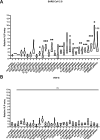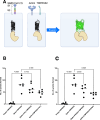Identification of host cell surface proteins inhibiting furin dependent proteolytic processing of viral glycoproteins
- PMID: 40659811
- PMCID: PMC12259872
- DOI: 10.1038/s41598-025-11164-x
Identification of host cell surface proteins inhibiting furin dependent proteolytic processing of viral glycoproteins
Abstract
Proteolytic cleavage by furin-like proteases is a crucial first step in the posttranslational modification of various glycoproteins found in enveloped emerging viruses, such as SARS-CoV-2 and highly pathogenic avian influenza A viruses (IAV). Here, we explored the capacity of host cell proteins identified by cell surface proximity ligation to limit the proteolytic cleavage of the SARS-CoV-2 spike and the IAV H5N1 hemagglutinin (HA). When co-expressed with recombinant SARS-CoV-2 spike protein, Prom1, Axl, and Ly75 suppress its proteolytic cleavage, whereas cleavage of HA was only reduced by Prom1. Co-immunoprecipitation assays suggest that Axl and Prom1 may form a complex with furin. Alteration of Prom1, Axl and Ly75 expression levels in Calu3 cells affected entry of SARS-CoV-2 S pseudotyped VLP and to a lesser extent, SARS-CoV-2 virions. In contrast, Prom1 levels did not affect entry of H5N1 VLPs or H5N1 virions. Our data highlight the differential capacity of SARS-CoV-2 and IAV H5N1 to cope with newly identified host restriction factors of furin activity.
© 2025. The Author(s).
Figures








Similar articles
-
The furin cleavage site is required for pathogenesis, but not transmission, of SARS-CoV-2.J Virol. 2025 Jul 22;99(7):e0046725. doi: 10.1128/jvi.00467-25. Epub 2025 Jun 10. J Virol. 2025. PMID: 40492735 Free PMC article.
-
The Tetraspanin CD9 Facilitates SARS-CoV-2 Infection and Brings Together Different Host Proteins Involved in SARS-CoV-2 Attachment and Entry into Host Cells.Viruses. 2025 Aug 20;17(8):1141. doi: 10.3390/v17081141. Viruses. 2025. PMID: 40872854 Free PMC article.
-
The Role of Long-Range Non-Specific Electrostatic Interactions in Inhibiting the Pre-Fusion Proteolytic Processing of the SARS-CoV-2 S Glycoprotein by Heparin.Biomolecules. 2025 May 28;15(6):778. doi: 10.3390/biom15060778. Biomolecules. 2025. PMID: 40563419 Free PMC article.
-
Physical interventions to interrupt or reduce the spread of respiratory viruses.Cochrane Database Syst Rev. 2023 Jan 30;1(1):CD006207. doi: 10.1002/14651858.CD006207.pub6. Cochrane Database Syst Rev. 2023. PMID: 36715243 Free PMC article.
-
Presence of SARS-CoV-2 and Its Entry Factors in Oral Tissues and Cells: A Systematic Review.Medicina (Kaunas). 2021 May 23;57(6):523. doi: 10.3390/medicina57060523. Medicina (Kaunas). 2021. PMID: 34070998 Free PMC article.
References
-
- WHO COVID-19 dashboard (2024).
MeSH terms
Substances
Grants and funding
LinkOut - more resources
Full Text Sources
Research Materials
Miscellaneous

